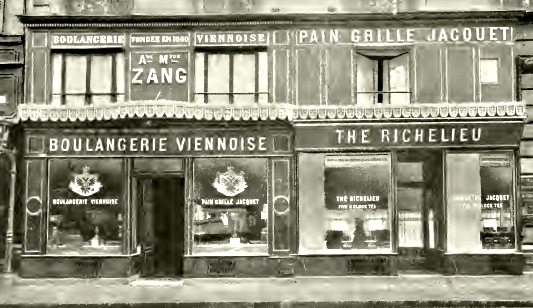When did “the viennoiserie” arrive in Paris?

In fact much of it can be dated precisely: 1839 (or possibly ’38). That was the year that a rather odd and ambitious fellow by the name of August Zang opened the Boulangerie Viennoise in Paris. A former artillery officer in the Austrian army, Zang sought to spread the glories of Austrian baking among the philistines to the West. Though his business at 92 rue Richelieu started off rather slowly, it wasn’t long before his breads — and especially his crispy laminated crescent rolls which were known in Austria as “kipfels” — caught on in Paris and spread like ze proverbial wildfire.
But it wasn’t just Austrian techniques that Zang was introducing to the Parisians. One aspect of the Viennoiserie that I failed to mention below is that it all requires a steam oven to make (or at least make well). Steam ovens were unheard of in Paris before the opening of Boulangerie Viennoise, and Zang flaunted his high-tech gear with showmanship worthy of P.T. Barnum. No human hand has touched them! read the inscription on the wall over his goods (in those days mechanization was a sign of quality).
Whatever happened to August Zang and why isn’t he more famous than he is (i.e. not at all)? Because less than ten years after he brought high-tech baking equipment to Paris, he left the citizens of that city to bring Parisian high-tech printing equipment back to Vienna, where he became a very wealthy and well-known publisher. Truly, Zang had a very unusual and fruitful career. Find out more about him here. As for when the viennoiserie formally became “the viennoiserie” and was taught as a subject in pastry schools, I’m not really sure. It would have been sometime in the 20th century.
Wow … baking AND publishing?
Is August Zang your hero, Joe? You can tell us….
Alright, ya got me. I’m still waiting for the part of my life where I become a favorite of royalty and buy my own castle. I keep thinking it’s just around the corner…
… but! What about Marie Antoinette? When it comes to french bread/baking culture, she plays a much, much more prominent role than Herr Zang, I believe… at an earlier time.
Hey Tom!
I think a lot of people credit Marie Antoinette with bringing Austrian baking to France because she was such a prominent Austrian import. However I’ve not seen much if any real documentation to that effect. Croissants are an excellent example. It’s said Antoinette introduced them, but mentions of the croissant in Paris don’t begin appearing in print until the 1850’s, not long after Zang’s arrival. The Chevallier book is exhaustively documented and makes a very powerful case. I highly recommend it.
– Joe
Enjoyed this bit of history…. thanks
Melissa
My pleasure, Melody!
– Joe
You bring me a chuckle every time I read your posts, Joe. Of all the blogs etc, professional and not, yours is the only one I check every day.
On the subject of Marie-Antoinette… Her famous quote, “Let them eat cake,” regarding the starving French populace was actually (supposedly?) “Qu’ils mangent de la brioche” or “Let them eat brioche.”
Any truth to that?
Heh, thanks Paul! As always it’s a great pleasure to have you check in. See the Marie Antoinette post on the main page for the answer to your question!
Cheers,
– Joe
That saying reminds me of one a fast food drive-in in Atlanta posted proudly on their serving ware – paper plates, hats, and cups – for years: “No Food Over Twelve Hours Old.” They removed that about twenty years ago for some reason.
Now to check your link. I learn so much here; thanks.
Thank YOU, Naomi!
– Joe
Nice to see Joe finally read that book I sent him. 🙂
The Marie-Antoinette thing is a myth; so is the idea that the pastry was invented at a siege of Vienna. (So are a bunch of other stories about famous foods found in a lot of very serious books; whole other issue).
And yes, Zang was a pretty interesting guy. Surprising he’s not more well-known. In Austria, people still read the paper he founded: Die Presse. But even the other ones follow a model of cheap dailies that he introduced (from Paris) into Austria. He did indeed try to hide his history as a baker – though not too well, since the French have long known him as “Baron Zang” and claimed he started as a Royal Chamberlain (both also myths) and even sometimes claim he brought the baguette to France (hardly).
Etc. If you want to know more, I can recommend a good book . 🙂 (I’ve got one on the baguette too.)
Yes, but I’ve promoted it consistently, that’s the main thing.
My (belated) compliments on a great piece of research!
– Joe
Thanks for some great history!
Really helped me find the answers for my gcse project, been searching for ages.
Thanks again, keep posting please:)
Lauren x
It’s my very great pleasure, Lauren! Thanks for stopping by.
– Joe